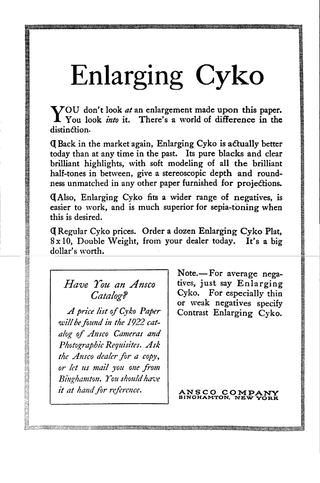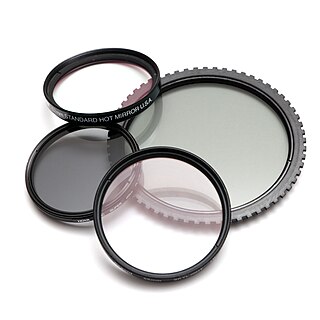

A safelight is a light source suitable for use in a photographic darkroom. It provides illumination only from parts of the visible spectrum to which the photographic material in use is nearly, or completely insensitive.


A safelight is a light source suitable for use in a photographic darkroom. It provides illumination only from parts of the visible spectrum to which the photographic material in use is nearly, or completely insensitive.
A safelight usually consists of an ordinary light bulb in a housing closed off by a coloured filter, but sometimes a special light bulb or fluorescent tube with suitable filter material or phosphor (in fluorescent tubes) coated directly on the glass is used in an ordinary fixture. More recently LEDs, which have a relatively narrow spectral bandwidth, are becoming more popular.
Differently sensitised materials require different safelights. In traditional black-and-white photographic printing, photographic papers normally are handled under an amber or red safelight, as such papers typically are sensitive only to blue and green light. Orthochromatic papers and films are also sensitive to yellow light and must be used only with a deep red safelight, not with an amber one. [1] Panchromatic films and papers, nominally sensitive to the entire spectrum, sometimes have a region of minimum in their range of sensitivity that allows the careful use of safelight confined to that part of the spectrum. For example, Kodak Panalure panchromatic paper is tolerant of limited exposure to light filtered through a Kodak 13 Safelight Filter. [2] Other panchromatic materials must be handled only in total darkness.
Many photosensitive materials used in technical and industrial applications, such as photoresist, are sensitive only to blue, violet, and ultraviolet light and may be handled under a brighter yellow safelight. Low-pressure sodium vapour lamps sometimes are used in larger industrial darkrooms. They emit nearly monochromatic light at 589 nm (yellow), to which the materials are insensitive; as a result they can be extremely bright while still "safe".[ citation needed ]
The word safe in safelight is relative, as in most cases, a sensitised material eventually will be affected by its safelight if exposed to it for an extended length of time. [3]

Color temperature is a parameter describing the color of a visible light source by comparing it to the color of light emitted by an idealized opaque, non-reflective body. The temperature of the ideal emitter that matches the color most closely is defined as the color temperature of the original visible light source. The color temperature scale describes only the color of light emitted by a light source, which may actually be at a different temperature.

Film stock is an analog medium that is used for recording motion pictures or animation. It is recorded on by a movie camera, developed, edited, and projected onto a screen using a movie projector. It is a strip or sheet of transparent plastic film base coated on one side with a gelatin emulsion containing microscopically small light-sensitive silver halide crystals. The sizes and other characteristics of the crystals determine the sensitivity, contrast and resolution of the film. The emulsion will gradually darken if left exposed to light, but the process is too slow and incomplete to be of any practical use. Instead, a very short exposure to the image formed by a camera lens is used to produce only a very slight chemical change, proportional to the amount of light absorbed by each crystal. This creates an invisible latent image in the emulsion, which can be chemically developed into a visible photograph. In addition to visible light, all films are sensitive to X-rays and high-energy particles. Most are at least slightly sensitive to invisible ultraviolet (UV) light. Some special-purpose films are sensitive into the infrared (IR) region of the spectrum.

Photographic paper is a paper coated with a light-sensitive chemical, used for making photographic prints. When photographic paper is exposed to light, it captures a latent image that is then developed to form a visible image; with most papers the image density from exposure can be sufficient to not require further development, aside from fixing and clearing, though latent exposure is also usually present. The light-sensitive layer of the paper is called the emulsion, and functions similarly to photographic film. The most common chemistry used is gelatin silver, but other alternatives have also been used.

A blacklight, also called a UV-A light, Wood's lamp, or ultraviolet light, is a lamp that emits long-wave (UV-A) ultraviolet light and very little visible light. One type of lamp has a violet filter material, either on the bulb or in a separate glass filter in the lamp housing, which blocks most visible light and allows through UV, so the lamp has a dim violet glow when operating. Blacklight lamps which have this filter have a lighting industry designation that includes the letters "BLB". This stands for "blacklight blue". A second type of lamp produces ultraviolet but does not have the filter material, so it produces more visible light and has a blue color when operating. These tubes are made for use in "bug zapper" insect traps, and are identified by the industry designation "BL". This stands for "blacklight".

A darkroom is used to process photographic film, make prints and carry out other associated tasks. It is a room that can be made completely dark to allow the processing of light-sensitive photographic materials, including film and photographic paper. Various equipment is used in the darkroom, including an enlarger, baths containing chemicals, and running water.

Color photography is photography that uses media capable of capturing and reproducing colors. By contrast, black-and-white or gray-monochrome photography records only a single channel of luminance (brightness) and uses media capable only of showing shades of gray.

In photography and cinematography, a filter is a camera accessory consisting of an optical filter that can be inserted into the optical path. The filter can be of a square or oblong shape and mounted in a holder accessory, or, more commonly, a glass or plastic disk in a metal or plastic ring frame, which can be screwed into the front of or clipped onto the camera lens.

An enlarger is a specialized transparency projector used to produce photographic prints from film or glass negatives, or from transparencies.
Photographic printing is the process of producing a final image on paper for viewing, using chemically sensitized paper. The paper is exposed to a photographic negative, a positive transparency , or a digital image file projected using an enlarger or digital exposure unit such as a LightJet or Minilab printer. Alternatively, the negative or transparency may be placed atop the paper and directly exposed, creating a contact print. Digital photographs are commonly printed on plain paper, for example by a color printer, but this is not considered "photographic printing".

High-intensity discharge lamps are a type of electrical gas-discharge lamp which produces light by means of an electric arc between tungsten electrodes housed inside a translucent or transparent fused quartz or fused alumina arc tube. This tube is filled with noble gas and often also contains suitable metal or metal salts. The noble gas enables the arc's initial strike. Once the arc is started, it heats and evaporates the metallic admixture. Its presence in the arc plasma greatly increases the intensity of visible light produced by the arc for a given power input, as the metals have many emission spectral lines in the visible part of the spectrum. High-intensity discharge lamps are a type of arc lamp.

In infrared photography, the photographic film or image sensor used is sensitive to infrared light. The part of the spectrum used is referred to as near-infrared to distinguish it from far-infrared, which is the domain of thermal imaging. Wavelengths used for photography range from about 700 nm to about 900 nm. Film is usually sensitive to visible light too, so an infrared-passing filter is used; this lets infrared (IR) light pass through to the camera, but blocks all or most of the visible light spectrum; these filters thus look black (opaque) or deep red.
A panchromatic emulsion is a type of photographic emulsion that is sensitive to all wavelengths of visible light, and produces a monochrome photograph—typically black and white. Most modern commercially available film is panchromatic, and the technology is usually contrasted with earlier methods that cannot register all wavelengths, especially orthochromatic film.
Actinism is the property of solar radiation that leads to the production of photochemical and photobiological effects. Actinism is derived from the Ancient Greek ἀκτίς, ἀκτῖνος. The word actinism is found, for example, in the terminology of imaging technology, medicine, and chemistry, and the concept of actinism is applied, for example, in chemical photography and X-ray imaging.
Wood's glass is an optical filter glass invented in 1903 by American physicist Robert Williams Wood (1868–1955), which allows ultraviolet and infrared light to pass through, while blocking most visible light.
In chemistry, orthochromasia is the property of a dye or stain to not change color on binding to a target, as opposed to metachromatic stains, which do change color. The word is derived from the Greek orthos, and chromatic (color). Toluidine blue is an example of a partially orthochromatic dye, as it stains nucleic acids by its orthochromatic color (blue), but stains mast cell granules in its metachromatic color (red).

Ultraviolet photography is a photographic process of recording images by using radiation from the ultraviolet (UV) spectrum only. Images taken with ultraviolet radiation serve a number of scientific, medical or artistic purposes. Images may reveal deterioration of art works or structures not apparent under light. Diagnostic medical images may be used to detect certain skin disorders or as evidence of injury. Some animals, particularly insects, use ultraviolet wavelengths for vision; ultraviolet photography can help investigate the markings of plants that attract insects, while invisible to the unaided human eye. Ultraviolet photography of archaeological sites may reveal artifacts or traffic patterns not otherwise visible.

Tanning lamps are the part of a tanning bed, booth or other tanning device which produces ultraviolet light used for indoor tanning. There are hundreds of different kinds of tanning lamps most of which can be classified in two basic groups: low pressure and high pressure. Within the industry, it is common to call high-pressure units "bulbs" and low-pressure units "lamps", although there are many exceptions and not everyone follows this example. This is likely due to the size of the unit, rather than the type. Both types require an oxygen free environment inside the lamp.

A multifaceted reflector light bulb is a reflector housing format for halogen as well as some LED and fluorescent lamps. MR lamps were originally designed for use in slide projectors, but see use in residential lighting and retail lighting as well. They are suited to applications that require directional lighting such as track lighting, recessed ceiling lights, desk lamps, pendant fixtures, landscape lighting, retail display lighting, and bicycle headlights. MR lamps are designated by symbols such as MR16 where the diameter is represented by numerals indicating units of eighths of an inch. Common sizes for general lighting are MR11 and MR16, with MR8 and MR20 used in specialty applications. Many run on low voltage rather than mains voltage alternating current so require a power supply.

Holiday lighting technology has been subject to considerable development and variation since the replacement of candles by electric lights. While originally used during the Christmas holidays as Christmas lights, modern electric light arrays have become popular around the world in many cultures and are used both during religious festivals and for other purposes unconnected to any festivities.

Photographic film is a strip or sheet of transparent film base coated on one side with a gelatin emulsion containing microscopically small light-sensitive silver halide crystals. The sizes and other characteristics of the crystals determine the sensitivity, contrast, and resolution of the film. Film is typically segmented in frames, that give rise to separate photographs.